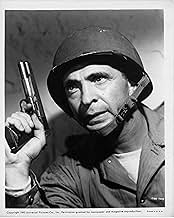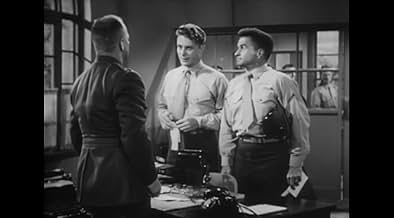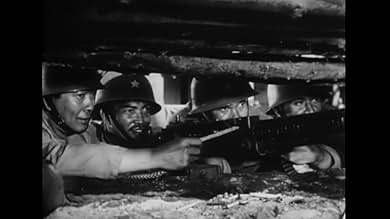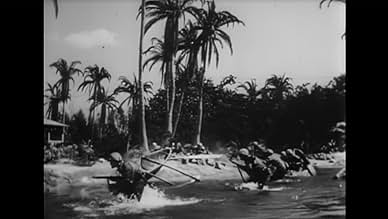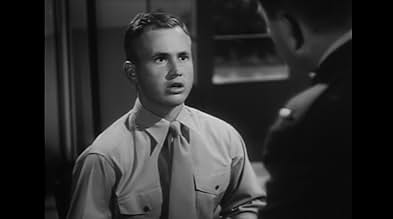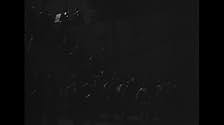1942. Sept semaines après l'attaque japonaise sur Pearl Harbour, un peloton de marines volontaires, après un voyage en sous-marin, commence à accomplir sa dangereuse mission : prendre le con... Tout lire1942. Sept semaines après l'attaque japonaise sur Pearl Harbour, un peloton de marines volontaires, après un voyage en sous-marin, commence à accomplir sa dangereuse mission : prendre le contrôle d'une île contrôlée par les Japonais.1942. Sept semaines après l'attaque japonaise sur Pearl Harbour, un peloton de marines volontaires, après un voyage en sous-marin, commence à accomplir sa dangereuse mission : prendre le contrôle d'une île contrôlée par les Japonais.
- Réalisation
- Scénario
- Casting principal
- Harry - the Hamburger Man
- (non crédité)
- Chief Clerk
- (non crédité)
- Mess Boy
- (non crédité)
Avis à la une
The film has been criticized for glamorizing what was essentially a band of cutthroats (Leonard Maltin even describes it as "a jaw-dropping experience"). Still, there was no doubt that any war picture made during this time wouldn't ram propagandist slogans down the audience's throat (witness Randolph Scott's final straight-into-camera speech); ironically, even if the latter was the film's nominal star, he's rarely involved in the action proper being there mainly to co-ordinate things, and repeatedly instigate his men to kill every Jap on the island!).
The supporting cast is good, made up of veteran character actors J. Carroll Naish, Sam Levene and newcomers notably Robert Mitchum; however, a fair share of the running-time is unwisely devoted to the romantic triangle involving a girl and two soldiers who happen to be half-brothers (one of them played by Noah Beery Jr.) all of which has a quite deadening effect on the main narrative! Despite being a relatively early WWII film, the action sequences are surprisingly gutsy though accentuated on occasion by obvious stock footage.
Though loaded with clichés such as rousing pre-battle speeches and over-dramatized death scenes, Gung Ho tells a more-or-less true story about the successful deployment of the Makin Raiders (Carlson's Raiders) on a minor Japanese stronghold (Makin Atoll). Fifteen thousand men volunteer, and in the end, only 200 make the team. These two hundred men will adopt the Chinese phrase Gung Ho (roughly translated as working harmoniously) as a philosophical approach to the task at hand.
In the military action film tradition, we are briefly introduced to each of the men whose battle experience will form the central action later in the film. The characters are surprisingly well-developed and realistic, but the laundry-list approach to character development doesn't work very well in terms of pace and cinematography. Once deployed, the Makin Raiders immediately spring into action, employing intelligence, an unusual degree of individual initiative, and great courage, to challenge the overwhelming odds against their capture of the island of Butaritari in the Makin Atoll.
The action sequences are quite entertaining, nicely thought-out, and the effects are brilliantly executed. From a pure action perspective, the film rates high for its time. The cinematography is quite good, the acting is OK, but hampered by some very mediocre directing. The early appearance of later legend Robert Mitchum is noteworthy, and Mitchum, even this early in his career, dominates every scene he is in.
Gung Ho, however, has been justly accused of propagandism and jingoism, as well as historical inaccuracy. Overall, given the fact that this film was released in 1943 within months of the securing of Guadalcanal by U.S. forces, this is hardly surprising.
From a civilian perspective, it's really just a 'pretty good' war film.
The second half involves a submarine ride and a raid on an island held by the Japanese. The action is surprisingly intense. Some scenes, like the shooting of Japanese out of trees reach the level of brutal poetic metaphor. These action scenes detail fierce fighting and are surprisingly even handed with both American and Japanese troops biting the dust pretty regularly.
Unlike, "Walk in the Sun" where the audience is given the chance to know and care about each soldier, there is only a pretty stereotyped introduction and then they are molded into one tough killing machine. The title "Gung Ho" we learn means "harmonious work" and that is what we get with precision maneuvers and no hesitation in the face of death on the battlefield.
One could call this communist propaganda, but without films like this, could fascism East and West have been defeated?
Le saviez-vous
- AnecdotesHarold Landon, who plays Frankie Montana, relates that the actors who played Japanese soldiers were actually Filipino and Chinese.
- GaffesThe U.S. Marines were not issued Garand semi-automatic rifles in wide numbers until after the Guadalcanal invasion, so it might be thought that the Raiders would have been using M1903 Springfield bolt-action rifles in the Makin raid in August, 1942, which happened as the Guadalcanal campaign began. However, as James Roosevelt, the President's son, was a member of the raiding party, the 2nd Marine Raider Battalion, the unit in the raid, were issued the most up-to-date weaponry, which included Garands; the Makin raid was, in fact, one of the first combat deployments of the M1.
- Citations
Lt.C.J.Cristoforos: A call has been issued by the commanding general for volunteers for a special battalion to be formed at once. Now this battalion will go into training for a particular combat duty overseas. Those men who can pass the severe requirements of this unit will be assured of immediate acts of service. The work involves close combat with the enemy, and only those men who are prepared to kill or be killed should apply. Those who accept it will be highly trained and will have every chance of survival. But it must be understood, the work is above and beyond the line of duty.
- Crédits fousPrologue: "This is the factual record of the Second Marine Raider battalion, from its inception seven weeks after Pearl Harbor, through its first brilliant victory."
- ConnexionsFeatured in Hollywood Parade (1944)
Meilleurs choix
- How long is 'Gung Ho!': The Story of Carlson's Makin Island Raiders?Alimenté par Alexa
Détails
Box-office
- Budget
- 866 898 $US (estimé)
- Durée
- 1h 28min(88 min)
- Couleur
- Rapport de forme
- 1.37 : 1

